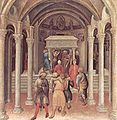Saint Nicholas

Saint Nicholas (Greek: Άγιος Νικόλαος, ayios nicholaos) (270–6 December 343),[1][2] or Nikolaos of Myra, was the Bishop of Myra.
He was born in the Greek colony[3] of Patara, in Asia Minor. Myra is near Antalya, in modern-day Turkey.
In the 11th century, his remains were taken to Bari, Italy, to save them from Turkish (Muslim) invaders.
He is the patron saint of very many groups, including thieves and murderers. So far as is known, what he did in that respect was to protect the falsely accused.[4]
He is venerated in both Eastern Orthodox and Catholic Churches.
Life
[change | change source]
His parents were relatively well-off. Nicholas is said to have distributed his fortune among the poor. This is relatively well documented. Less documented deeds of his include saving children from drowning. Nicholas saved young girls from being made prostitutes (because their fathers did not have the money for a dowry). He helped seamen in a storm and saved a child that was abducted.
In the Eastern Orthodox Church, Saint Nicholas of Myra is a very prominent figure. Very often, the third large icon on the Iconostasis in Orthodox churches is devoted to him. The other two are usually devoted to Jesus, and to Mary with the child.[5]
The Cantata by Benjamin Britten
[change | change source]The modern composer Benjamin Britten composed a cantata for orchestra and choir about the life of St. Nicholas. It is very popular and often performed.
In modern times
[change | change source]He is the Saint behind the legendary character of Santa Claus. He is the patron Saint of Children, of Seafarers and merchants. The Hanseatic League chose him as their patron saint. Over 400 churches and several thousands all over the world are named after Nicholas of Myra.[6][7] He is also the patron saint of both Amsterdam, capital of Netherlands and Moscow, capital of Russia.[8]
Images
[change | change source]-
Tryptych in Bari. Gentile da Fabriano, about 1425.
-
Sinter Claes in de Dam (Amsterdam)
-
A modern metal icon of St. Nicholas by the Bulgarian artist Georgi 'Chapa' Chapkanov, depicting the patron saint of fishermen holding a fish. Gilbert House, Stanley, Falkland Islands.
Related pages
[change | change source]References
[change | change source]- ↑ "Who is St. Nicholas?". St. Nicholas Center. Retrieved 7 December 2010.
- ↑ "St. Nicholas". Orthodox America. Archived from the original on 7 September 2011. Retrieved 7 December 2010.
- ↑ David D. Mulroy, Horace, Quintus Horatius Flaccus 1994, “Horace's Odes and Epodes” – p.183
- ↑ "Saint Nicholas ::: People". stnicholascenter.org. Retrieved February 9, 2011.
- ↑ "Iconostasis definition at the Catholic Encyclopedia".
- ↑ "About St Nicholas". Retrieved 2009-11-29.
- ↑ "Iconostasis". OrthodoxWiki.
- ↑ Saint Nicholas ::: Places




